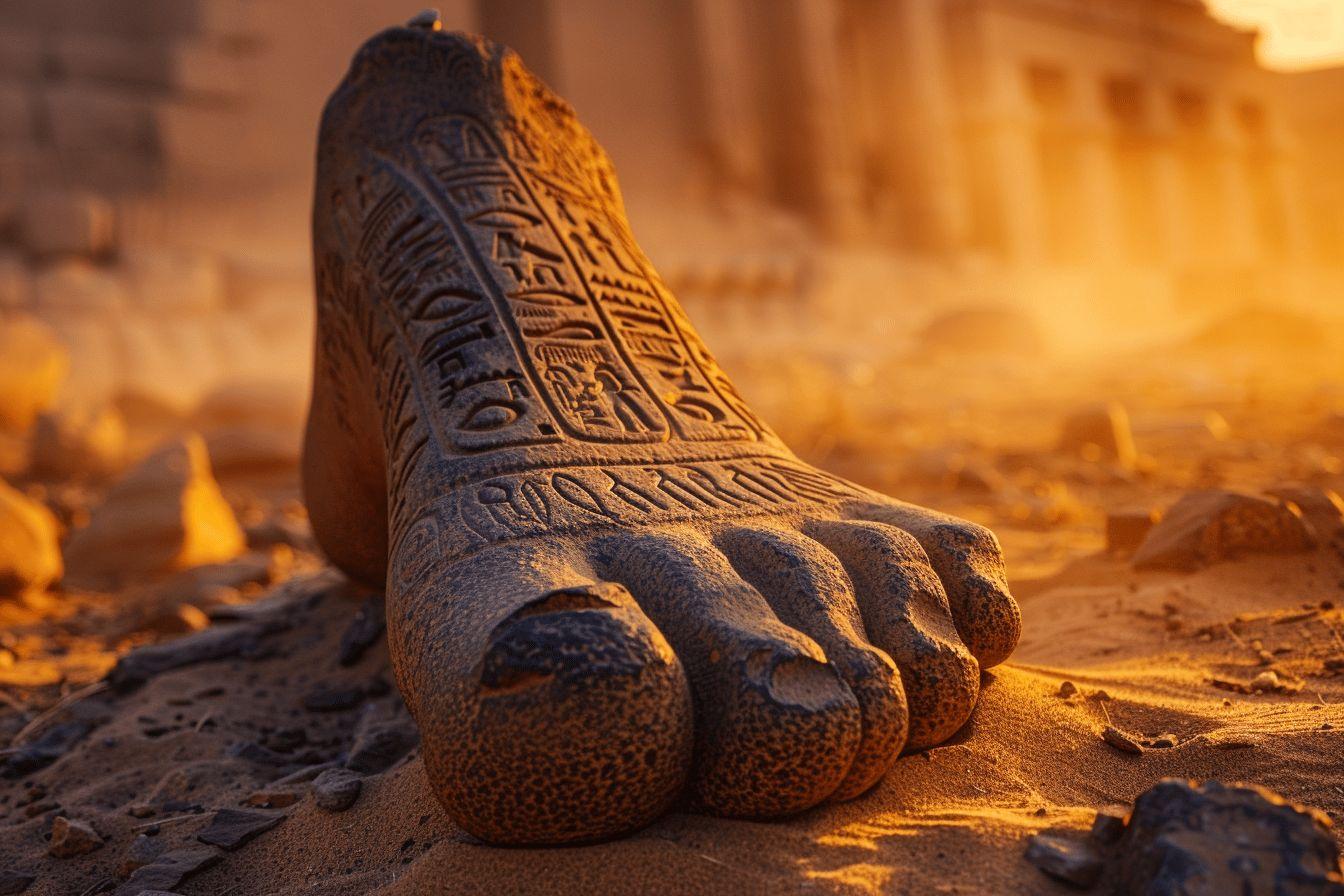The Egyptian foot, a fascinating anatomical feature, is characterized by a big toe that is longer than the others. Here are the key points to remember:
- Origin: Named after the art of Ancient Egypt
- Prevalence: Present in 40 to 50% of the world's population
- Implications: Can influence choice of footwear and sports practice
- Care: Requires special attention to prevent certain podiatric risks
The Egyptian foot, a fascinating anatomical feature, intrigues podiatrists and ancient history enthusiasts alike. This unique toe configuration arouses curiosity and raises many questions. Let's dive into the captivating world of this morphological specificity to discover all its secrets.
Characteristics and Origin of the Egyptian Foot
The Egyptian foot is distinguished by a particular configuration of the toes. In this morphology, the big toe is longer than the others, and the following toes gradually decrease in length. This arrangement creates a characteristic diagonal line running from the big toe to the little toe.
The term "Egyptian foot" originates from ancient Egyptian art. Pictorial and sculptural representations of this period often depicted figures with elongated feet and a prominent big toe. This aesthetic peculiarity has survived over the centuries to become a medical term designating this specific morphology.
It should be noted that the Egyptian foot is not an anomaly, but rather a natural variation in the shape of the foot. This configuration is present in approximately 40 to 50% of the world's population, making it one of the most common foot shapes.

The Different Types of Feet and Their Prevalence
The Egyptian foot is not the only foot shape that exists. In reality, there are three main morphologies:
- The Egyptian foot: big toe longer than the others
- The Greek foot: second toe longer than the big toe
- The square foot: all toes are approximately the same length
The prevalence of these different morphologies varies among populations and regions of the world. Here is a summary table of distribution estimates:
| Foot Type | Estimated Prevalence |
|---|---|
| Egyptian Foot | 40-50% |
| Greek Foot | 15-20% |
| Square Foot | 30-35% |
These figures may vary slightly depending on the studies and populations studied. Note that some people may have a combination of these morphologies, for example, with an Egyptian foot on one side and a Greek foot on the other.
Implications of the Egyptian Foot on Health and Lifestyle
The Egyptian foot morphology can have various implications for the health and daily life of those affected. Although this configuration is not inherently problematic, it can influence certain aspects of life:
Choice of Shoes: People with an Egyptian foot may sometimes have difficulty finding suitable shoes. The length of the big toe may require more space in the front of the shoe. It is therefore recommended to choose models that offer sufficient room for the toes.
Sports: Certain sports, particularly those involving sudden movements or rapid changes of direction, can place greater strain on the big toe. People with Egyptian feet should pay particular attention to protecting and strengthening this area to prevent injuries.
Podiatric Risks: Egyptian feet may be associated with a slightly increased risk of certain conditions, such as:
- Hallux valgus (bunion)
- Corns or calluses on the big toe
- Ingrown toenails
It is important to emphasize that these risks are not systematic and that good podiatric hygiene generally allows them to be effectively prevented.
The Egyptian Foot in History and Culture
Beyond its medical aspects, the Egyptian foot has played an interesting role in history and culture. In ancient Egypt, this morphology was considered an aesthetic ideal. Pharaohs and nobles were often depicted with elongated feet and a prominent big toe, a symbol of grace and distinction.
This fascination with foot shape also manifested itself in other cultures. In ancient China, for example, the practice of foot binding aimed to achieve a particular shape, albeit one very different from the Egyptian foot. In Renaissance Europe, artists such as Leonardo da Vinci studied the proportions of the human body, including those of the feet, similarly influencing the perception of anatomical beauty.
Today, the diversity of foot morphologies is more widely recognized and celebrated. Podiatrists and anthropologists continue to study these variations to better understand human evolution and the biomechanical adaptations of our species.
Taking Care of Your Egyptian Foot
If you have an Egyptian foot, there's no need to worry. This morphology is completely natural and generally does not require any special treatment. However, a few tips can help you take care of your feet:
Choose the Right Shoes: Opt for models with enough room in the forefoot. Avoid shoes that are too narrow or pointy, which could compress your toes.
Practice Good Podiatric Hygiene: Wash and dry your feet thoroughly daily, paying particular attention to the spaces between your toes. Cut your nails straight across to prevent ingrown toenails.
Do strengthening exercises: Simple exercises like gripping objects with your toes can help maintain flexibility and strength in your feet.
By following these recommendations and paying attention to your feet, you can take full advantage of your unique shape. The Egyptian foot, far from being a handicap, is a fascinating anatomical feature that demonstrates the diversity and richness of the human body.





Leave a comment
This site is protected by hCaptcha and the hCaptcha Privacy Policy and Terms of Service apply.